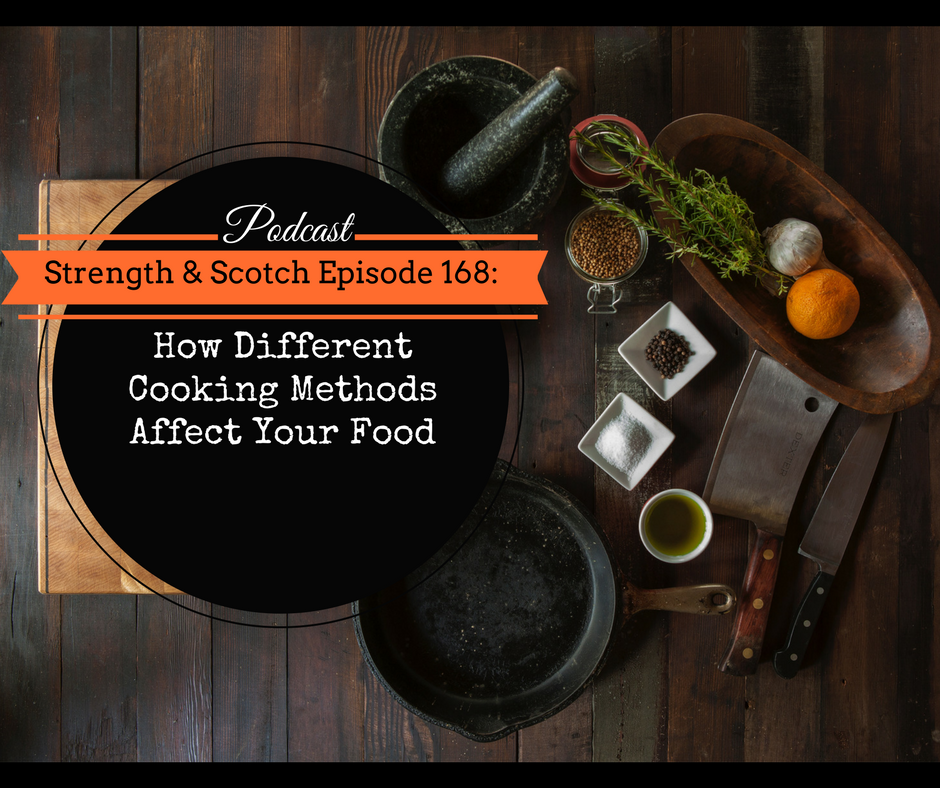SS 168 – How Different Cooking Methods Affect Your Food
Episode 168 Show Notes
Grant and Heavey sit down to chat about cooking methods and how they affect micronutrients, absorption and overall health: Does grilling form carcinogens?
Is microwaving bad?
What’s the best way to preserve vitamins and minerals in your food?
Tune in to hear the nitty gritty on the best ways to cook protein, fats and carbs for taste AND for your health.
All this and more on this episode! First off, a shout out to our Health IQ for sponsoring this show.
[04:10] Why Diets Backfire Grant mentions a study he read about why diets backfire. A year or more after weight loss, the desire to eat grows stronger. You start to feel more hungry in general and less full after a meal. The hardest part in losing weight is keeping it off. The study published in the American Journal of Physiology, Endocrinology, and Metabolism explores the body’s tenaciousness and multi-pronged approach to weight loss in a bid to ensure that the weight loss is regained. Now, Heavey says that looking at the follow up data about the participants from the show, The Biggest Loser, who lost an enormous amount of weight. After taking some measurements on their metabolism, they saw a dramatic decrease in metabolic function (the number of calories burned on a daily basis). What led to that? Some speculate it was because of the crash diet approach of the show. Moreover, on a larger scale, people tend to work in extremes because that’s how most health and fitness information is presented to them. Grant goes on to say that the study also looked into the endocrinology aspect of it, they found there’s an appetite-boosting hormone that had risen rapidly. This was in response to doing so much more exercise. In the study, they’re exercising up to three hours a day. There was not a desire to eat because they found a corresponding increase in the satiety hormones so they feel more full in the wake of eating a meal. At the end of the year of dieting, they reported a significant increase in their hunger and desire to eat. All the sensations of fullness they had after meals had plummeted. Their hormones levels continued to show increases in appetite-stimulating compounds.
[09:00] Food Preparation versus Meal Preparation Meal preparation entails making a bunch of meals at once and then packing them up for storage. On the other hand, food prep is how you prepare your food before you eat them – grilling, boiling, baking, steaming, braising, deep-frying, and so much more. All of these preparation methods have an effect on the nutrients that are in the food and whether we lose the nutrients or a large percentage of them. Also, discussing if different preparation methods can increase the harmful compounds.
[10:40] Raw Foods For example, there are raw vegans which to them raw foods are the best foods. Grant adds that there’s this built-in idea in our modern society that the more simple, more natural, and the closest to the source, the better. So what’s more natural than eating raw? However, Heavey points out that one of the benefits of cooking food is it reduces exposure to foodborne pathogens. Researchers suggest that introducing cooked foods into the human behavior patterns is one of the primary drivers of the evolution of our brains. Another case in point, is that it’s difficult to eat a lot of raw foods. The nature of cooking allows us to consume more of it. Additionally, cooking can actually increase the bioavailability of certain nutrients in food. On the other side, cooking can decrease antioxidant content in foods. It may possibly increase carcinogen composition within the food as well.
[14:00] Using a Microwave Is Actually Healthy? There is this perception in the GMO and organic food community that microwaving your food destroys nutrients or can be harmful. However, microwaving is actually one of the best methods for heating food. It’s cooking with magic! Microwave ovens use radiation and people are actually afraid of it, but it’s really just like how we get radio in our cars. Radiation comes in a whole plethora of different frequencies and microwave happens to be around the same frequency that your wireless router operates. The idea is that these frequencies can somehow hurt you but microwaves are very well-shielded. So there’s really nothing to worry about. How microwaving actually works is that the radiation hits the water molecules present in food. These molecules get excited so the food is heated from inside-out. Hence, this causes the food to retain most of their nutrients.
[17:00] Boiling Your Food: Yay or Nay? When you boil your food, they’re fully immersed in water. Now, the water-soluble vitamins in them can get washed away as you’re cooking the food. One exception to this is soup. If you boil your foods and you consume its water, then you’re going to get all of the nutrients back. The same applies to a slow cooker.
[18:00] Stir-Frying Your Food Stir-frying is done when you’re putting oil or butter on a skillet and then pan fry your food there. This is fine but you could run the risk of overheating the food or oils that you’re cooking the food with. That’s where it starts to cause fat oxidation that can lead to consuming unhealthy compounds. Nevertheless, you may have heard of people saying that cooking food with certain oils or butter is more beneficial than others. Saturated fats are the most temperature-stable fats. They’re solid at room temperature. Examples include butter, coconut oil, and lard. Also be aware of the temperature you’re cooking at. The higher the heat, the more likely you’re going to oxidize those fats. The avocado oil is a very stable fat and Heavey thinks this is one oil people should be comfortable cooking with. Ultimately, there’s this perception that cooking with fat can be bad. But there are nutrients we consume that are fat-soluble. So frying food in fat can help the absorption of those nutrients from your foods.
[22:25] What’s Wrong with Deep-Frying? The issue with deep frying is that it’s high temperature cooking. Often times, this is done when you cook meat. Now, meat at high temperature can form these compounds that have found to be carcinogens. So it’s something you need to be aware of. Additionally, there’s this nature of continued re-heating of oil. This is what fast food restaurants do in their deep fryers. They’re not emptying out the fryer after they make a single batch of french fries since they’re reusing the oil over and over again. In other places, they don’t clean their deep fryer well so there could be lingering oil there for a very long time. Continued reheating of these oils increases these substances called aldehydes which can be harmful for you. Assuming you’re using good oil, you can cook healthy food in a deep fryer. But by and large, people buying food from commercial restaurants should be aware of this.
[24:35] Hot on the Grill! Although this is Grant and Heavey’s favorite way of cooking, grilling may actually pose a risk to your health. Charred meat and more well-done tend to have higher frequency of harmful substances that can lead to cancer. Examples are heterocyclic amines (HCAs), polycyclic aromatic hydrocarbons and the advanced glycation end-products (AGEs). These substances could increase your risk of cancer and atherosclerosis. That being said, grilling per se is not bad, just make sure you’re not eating the charred portion. You don’t have to stop grilling but be aware of overcooking meat when on the grill. Another issue with grilling is that often times, the nutrients are dripping down into the drip pan. So you’re losing certain nutrients while you’re grilling. Now if you can capture that and reuse it, then all good. It’s just like when you’re cooking soup where you could be losing the nutrients but still you’re able to reclaim them.
[28:00] Steaming Is King: Should You Steam Your Food Each Time? Steaming is one of the best ways for preserving nutrients in foods when cooking food, especially vegetables. Heavey doesn’t always steam his food. When you’re looking for the best way to cook your food, it actually depends on your own context. The best way to prepare food is the way you will enjoy eating it. Maybe roasting vegetables wouldn’t allow you to retain the most nutrients, but it’s the way you’re going to eat vegetables and that’s the way you should do it.
[29:50] Blending, Roasting, and Fermentation Blending is a method for consuming raw foods that does some of the digestive work for you. Roasting is probably the healthiest when cooking meat as is smoking since you’re using low temperature heat. Also, the length of time factors into the frequency of the harmful compounds. Fermentation is another powerful method for preparing your food. In a nutshell, Heavey wants to point out that the best method for food preparation is the one you’re going to eat well.
[34:13] Time for Scotch! Grant is pulling another bottle of scotch, a 100% Islay. It’s a rare bottle where they use 100% of the materials from the Islay. As with bottles like Laphroaig, Ardbeg, and Lagavulin, all these are Islay whiskey but almost none of the grain (barley, malt) comes from Islay. It’s just the work that happens on Islay. The bottle is obviously young with its almost clear color, unchillfiltered, no color added. Grants says this is a good lesson that young whiskeys can still be absolutely delicious. Flavor-wise, it’s light and very peaty, without being overwhelming. There’s complexity to it. Heavey says it doesn’t take like fire and that it’s a great peated whiskey that’s not “in your face.”
Links: Why Diets Backfire
Check out the gear page for everything Strength & Scotch! You’ll find a listing of all the supplements and other programs we’ve discussed on the show as well as our killer t-shirts!
[ois skin=”StrengthAndScotch”]


